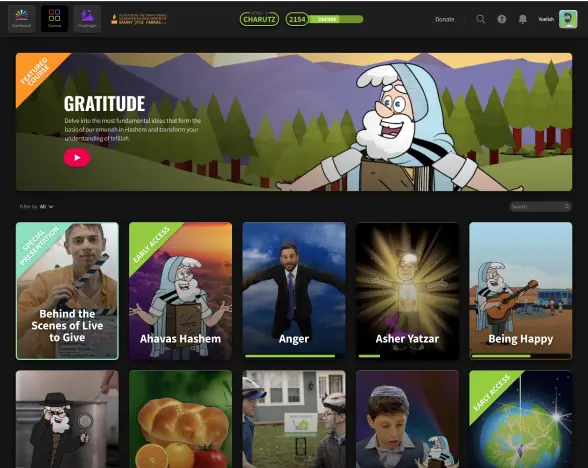
How moving a single dot teaches children resilience and joy
What if I told you that moving a single dot could teach your child one of life's most powerful lessons? In the Hebrew alphabet, the difference between a Shin and a Sin is just that — one small dot that moves from one side to the other. But this simple transformation holds profound wisdom about resilience, creativity, and finding joy even in scary situations.
The magic of small changes
Watch any young child learning Hebrew, and you'll see their eyes light up when they discover that Shin becomes Sin with just the movement of a dot. It's not magic — it's something even more powerful. It's the Torah teaching us that sometimes the smallest adjustments create the biggest transformations.
The Gemara teaches us "lefum tza'ara agra" — according to the effort is the reward. But what about when the effort seems so small? Moving a dot hardly feels like work at all. Yet this tiny change completely transforms the letter's identity and sound. Your child isn't just learning Hebrew; they're absorbing a fundamental truth about growth and change.
When fear meets creativity
The story of Simcha helping his frightened sister at the farm isn't just entertainment — it's a masterclass in emotional intelligence. When his sister feared the goats would chew her dress and hair, Simcha didn't dismiss her concerns or force her to "be brave." Instead, he got creative.
He gave her seeds to feed the goats, transforming potential threat into peaceful interaction. Then when she couldn't figure out how to cross to the other side, he showed her she could simply jump. Both solutions required the same principle as Sin and Shin: a small shift that changes everything.
Rabbi Dessler's teachings about becoming a giver rather than a taker come alive in this simple story. Simcha could have ignored his sister's distress, but instead he chose to give — his attention, his creativity, and his encouragement. The result? She went from tears to smiles, from fear to confidence.
Building Hebrew through relationship
Notice how the Hebrew vocabulary emerges naturally in the story: Simla (dress), Sa'ah (hair), and Simcha (joy). These aren't random word lists to memorize. They're woven into a narrative about caring for others and overcoming challenges together.
This mirrors how we should approach all Torah learning with our children. The interactive approach in this Hebrew adventure shows children that letters aren't just shapes on a page — they're tools for connection, communication, and kindness.
When your child sees that the same letters spelling "Simla" (what we wear) also appear in "Simcha" (what we feel when we help others), they're not just building vocabulary. They're discovering that Hebrew carries layers of meaning that connect the physical and spiritual worlds.
From fear to joy: the Jewish way
The transformation from Shin to Sin teaches us something profound about facing difficulties. We don't always need to completely change our circumstances — sometimes we just need to shift our perspective. The goats didn't disappear, but they became friendly when offered seeds instead of feared as threats.
This echoes the deeper Jewish concept of turning darkness into light, as we see throughout our calendar year. Purim transforms potential destruction into celebration. Pesach turns slavery into freedom. The pattern repeats: what seems impossible becomes achievable with the right approach and Divine assistance.
Practical steps for parents
Here are five ways to bring these lessons home:
Create "dot moving" moments. When your child faces a challenge, help them identify one small thing they can change or try differently. Show them how Shin becomes Sin with just a moved dot, then help them find their own "small move" solution.
Practice Hebrew through storytelling. Don't just drill letters — embed them in stories about helping others. Let your child be the hero who uses Hebrew words to solve problems or spread joy.
Turn fear into curiosity. When your child expresses fear about something new, follow Simcha's example. Don't dismiss the fear, but help them brainstorm creative approaches that transform the scary situation.
Celebrate small victories. Every correctly identified letter, every new Hebrew word learned, every act of kindness deserves recognition. Build their confidence through consistent positive reinforcement.
Connect letters to character. Show them how Hebrew words for positive traits (like Simcha for joy, Chessed for kindness) use the same letters they're learning. Help them see that they're not just learning an alphabet — they're building tools for living a meaningful life.
The lasting impact
Years from now, your child might not remember every detail of the Sin story. But they'll carry something more valuable: the knowledge that small changes can create big transformations, that creativity can overcome fear, and that helping others brings the deepest joy.
Every time they see a Sin, they'll remember that it's just a Shin with the dot moved to "the other side" — and maybe they'll remember that sometimes all we need to do is jump to that other side too.
Ready to turn Hebrew learning into joyful family adventures? Join thousands of parents discovering how Torah Live's engaging videos and interactive activities make every lesson stick. Sign up free and watch your children ask for more learning time!
